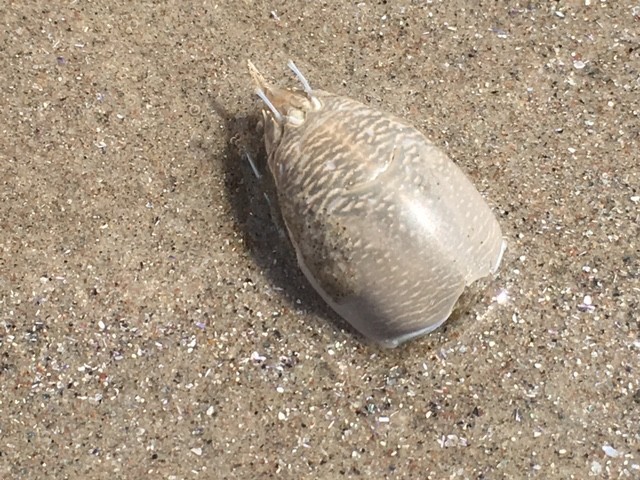A walk on the beach yields a surpising find—the mole crab
I’ve always thought that I was reasonably attentive to the natural world surrounding me. And yet, I am finding out that there is so much that is happening undetected right under my nose. For example, with my new backyard birdfeeder — which began as a whim — varieties of birds have popped up that I have never seen before.
Yes, we all know the robins, the jays and the cardinals. But all of a sudden I am learning about brown-headed cowbirds and hairy woodpeckers.
So in this vein, I’ll share with you an unexpected adventure walking along the beach at Coney Island. It’s has been many, many years since I walked along that beach but when I was much younger, I remember many a lazy summer day, reading on a beach blanket, working on my tan when we thought a tan was a sign of beauty.
And I love beachcombing, although Coney Island was a very poor location even then for serious shell hunting.
All I remember, in those days, were endless mussel and clam shells. So walking out a few weeks ago I was not expecting much of interest but the real fun, in any case, is the hunt!
Finding mussel shells again with the occasional lam shell which reinforced my recollections. I even found one oyster shell which was a surprise although apparently there is an effort to reseed nearby Jamaica Bay with oysters which might explain it.
However, when my young grandson noticed activity in the wet sand of the swash zone — the area of breaking waves — things became infinitely more interesting.
My first reaction to everything new in the outdoors is to try to get a clear photo which I’m sharing. After snapping the creature from above, we turned it over and my first reaction was that it was a baby horseshoe crab.
Horseshoe crabs undergo several molts before becoming adult and given the creature’s legs and underside appearance, I thought it might be an early form, although the appearance was at variance with an adult horseshoe crab.
When in doubt, you need the help of a professional. I called the offices of the Wildlife Conservation Society (WCS) and they had me e-mail my request for ID to guestrelations@wcs.org and I received a swift reply. The picture was that of a mole crab — also called sand crabs, sand fiddlers or sea cicadas — which I had never heard of before.
In terms of scientific classification, mole crabs are not even closely related to horseshoe crabs, although they are both found in the phylum Arthropoda.
However, horseshoe crabs are located in the family Limulidae and have an evolutionary history that goes back about 450 million years, while mole crabs are in family Hippidae and its evolutionary history is shorter and murkier. There are no described fossils to rely on but information based on the molecular clock implies that the family evolved before the mid-to-late Pliocene. The Pliocene ranged from 5.3-2.6 million years ago so we are talking only a few million years ago.
Sand crabs are crustaceans — which include lobsters, crayfish, shrimp and krill — from the Order Decapoda. In Greek, “deca” means ten and “pod” means foot and indeed they have five pairs of legs.
They form an important part of the diet of sea birds, shore birds and fish. Despite heavy predation, sand crab are maintaining their populations because the female can lay up to 45,000 eggs from February to October. These eggs drift out to sea and hatch in about a month later. It takes another 4-5 months for them to reach maturity.
They can be found in the ocean waters and on shore in the swash zone, coming ashore as wave riders. They bury themselves quickly in the sand, using just their hind feet, leaving only their eyes and antennae above the sand.
As the waves receded, they uncoil their antennae and attempt to feed on the plankton present in the water flowing past. Since they are filter-feeders, they act as sentinels for domoic acid, the neurotoxin produced by algae that can become concentrated in shellfish and cause amnesic shellfish poisoning in humans.
It called amnesic since, among other effects, it can cause memory problems. Scientists, therefore, use sand crab tissue to measure amounts of domoic acid in the local sea water. In addition, the mole crab is also used in neurology studies because they have the largest sensory neurons in the Animal Kingdom.
Many aquariums now have “Touch Tanks” where children and adults can safely handle small sea creatures such as sea urchins, rays and starfish. Mole crabs might make a fine addition!






